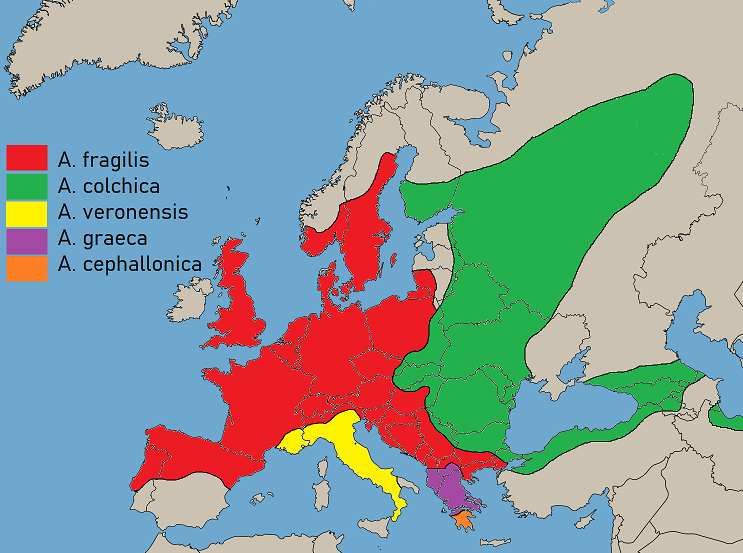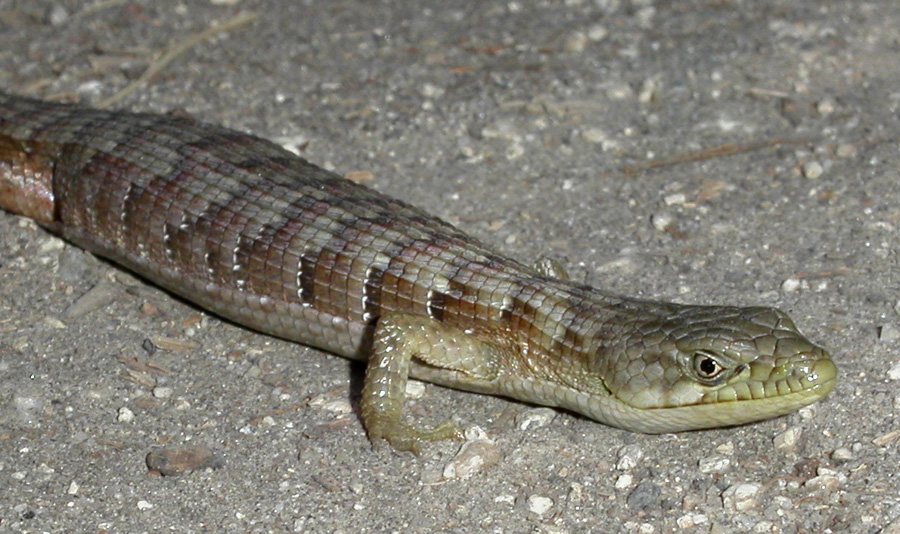|
Anguidae
Anguidae refers to a large and diverse family of lizards native to the Northern Hemisphere. It contains 9 genera and 89 extant species. Common characteristics of this group include a reduced supratemporal arch, striations on the medial faces of tooth crowns, osteoderms, and a lateral fold in the skin of most taxa. The group is divided into two living subfamilies, the legless Anguinae, which contains slow worms and glass lizards, among others, found across the Northern Hemisphere, and Gerrhonotinae, which contains the alligator lizards, native to North and Central America. The family Diploglossidae (which contains the galliwasps) was also formerly included. Morphology and reproduction Anguids have hard osteoderms beneath their scales giving them an armored appearance. Members of the subfamily Anguinae have reduced or absent limbs, giving them a snake-like appearance, while members of Gerrohonotinae are fully limbed. Body type varies among species, with sizes ranging from ... [...More Info...] [...Related Items...] OR: [Wikipedia] [Google] [Baidu] |
Glyptosaurinae
Glyptosaurinae is an extinct subfamily (biology), subfamily of anguid lizards that lived in the Northern Hemisphere during the Late Cretaceous and the Paleogene. Description Glyptosaurines are known primarily from their osteoderms, scale-like pieces of bone that are embedded in the skin and cover much of their bodies. The shape and extent of the osteoderms in glyptosaurines are similar to those seen in an unrelated group of lizards called Monstersauria, which includes the living Gila monster and beaded lizard. The osteoderms of glyptosaurines are unusually complex, consisting of four distinct layers of bony tissue. These tissues may have derived from both the dermis (the lower layer of the skin) and the epidermis (skin), epidermis (the outer layer of the skin) during their development in the embryo. The tissue forming the outermost layer of glyptosaurine osteoderms is similar to tooth enamel and has even been given its own name, osteodermine. Glyptosaurines have been split into ... [...More Info...] [...Related Items...] OR: [Wikipedia] [Google] [Baidu] |
Gerrhonotus
''Gerrhonotus'' is a genus of anguid lizards that are commonly referred to as alligator lizards, due to a vague resemblance to an alligator. Most species are restricted to Mexico, but a few range into Guatemala or Texas, and ''G. rhombifer'' is from Costa Rica and Panama. Along with glass lizards (''Ophisaurus'') and many other lizards, alligator lizards have the ability to regrow their tail. Species and subspecies There are nine recognized species in the genus ''Gerrhonotus''. One species has recognized subspecies. www.reptile-database.org. *'' Gerrhonotus farri'' – Farr's alligator lizard Beolens, Bo; Watkins, Michael; Grayson, Michael (2011). ''The Eponym Dictionary of Reptiles''. Baltimore: Johns Hopkins University Press. xiii + 296 pp. . (''Gerrhonotus farri'', p. 88; ''G. liocephalus loweryi'', p. 161; ''G. lugoi'', p. 162). *'' Gerrhonotus infernalis'' – Texas alligator lizard *''Gerrhonotus lazcanoi'' *'' Gerrhonotus liocephalus'' – smooth-headed alligator ... [...More Info...] [...Related Items...] OR: [Wikipedia] [Google] [Baidu] |
Anguis Fragilis
The common slow worm (''Anguis fragilis'') is a species of legless lizard native to western Eurasia. It is also called a deaf adder, blindworm, or regionally, a long-cripple, steelworm, and hazelworm. The "blind" in blindworm refers to the lizard's small eyes, similar to a blindsnake (although the slow worm's eyes are functional). The common slow worm, i.e. the species ''Anguis fragilis'', is often called simply "slow worm", though all species of the species complex comprising the genus ''Anguis'' are also called "slow worms". Common slow worms are semifossorial (burrowing) lizards that spend much of their time hiding underneath objects. The skin of slow worms is smooth, with scales that do not overlap. Like many other lizards, they autotomize, meaning that they have the ability to shed their tails to escape predators. While the tail regrows, it does not reach its original length. In the UK, slow worms are commonly encountered in gardens and allotments, where they can be enco ... [...More Info...] [...Related Items...] OR: [Wikipedia] [Google] [Baidu] |
Helodermoides Tuberculatus
''Helodermoides'' is an extinct genus of anguid lizards from the Oligocene of North America. The genus is monotypic, including only the species ''Helodermoides tuberculatus''. ''Helodermoides'' belongs to an extinct subfamily of anguids called Glyptosaurinae. In addition to many fragmentary bones, several complete skeletons of ''Helodermoides'' are known. Like other glyptosaurines, ''Helodermoides'' was covered in small scale-like bones called osteoderms. The osteoderms covering its skull are hexagonal, tightly interlocking, raised, and rounded. One fossil of ''Helodermoides'' preserves a fused mass of osteoderms at the tip of a shortened tail, thought to represent healing after the end of the tail fell off. The tail would not have been able to grow back because the osteoderms formed a thick bony cap preventing growth. The ability to lose a tail, called autotomy, is also present in living anguid Anguidae refers to a large and diverse family of lizards native to the Northern Hem ... [...More Info...] [...Related Items...] OR: [Wikipedia] [Google] [Baidu] |
Elgaria
''Elgaria'' is a genus of New World lizards in the Family (biology), family Anguidae. Their common name is western alligator lizards. There are seven species in the genus. Geographic range Species in the genus ''Elgaria'' are distributed in western North America, from Mexico to Canada. Species There are seven species: ''Nota bene'': A Binomial nomenclature, binomial authority in parentheses indicates that the species was originally described in a genus other than ''Elgaria''. References Further reading *John Edward Gray, Gray JE (1838). Catalogue of the Slender-tongued Saurians, with Descriptions of many new Genera and Species. ''Ann. Mag. Nat. Hist., First Series'' 1: 274–283, 388–394. (''Elgaria'', new genus, p. 390). *Gray JE (1845). ''Catalogue of the Specimens of Lizards in the Collection of the British Museum.'' London: Trustees of the British Museum. (Edward Newman, printer). xxviii + 289 pp. (Genus ''Elgaria'', p. 46). *Robert C. Stebbins, Stebbins R ... [...More Info...] [...Related Items...] OR: [Wikipedia] [Google] [Baidu] |
Barisia
''Barisia'' is a genus of lizards in the family Anguidae. The genus is endemic to Mexico. Species The following species are recognized as being valid."''Barisia'' ". The Reptile Database. www.reptile-database.org. http://reptile-database.reptarium.cz/advanced_search?genus=Barisia&submit=Search *'' Barisia ciliaris'' – Sierra alligator lizard, imbricate alligator lizard *''Barisia herrerae'' – Herrera's alligator lizard *'' Barisia imbricata'' – imbricate alligator lizard, transvolcanic alligator lizard *'' Barisia jonesi'' – imbricate alligator lizard *'' Barisia levicollis'' – Chihuahuan alligator lizard *'' Barisia planifrons'' – Oaxaca alligator lizard *'' Barisia rudicollis'' – rough-necked alligator lizard ''Nota bene ( ; plural: ) is the Latin language, Latin phrase meaning ''note well''. In manuscripts, ''nota bene'' is abbreviated in upper-case as NB and N.B., and in lower-case as n.b. and nb; the editorial usages of ''nota bene'' and ''not ... [...More Info...] [...Related Items...] OR: [Wikipedia] [Google] [Baidu] |
Pseudopus
''Pseudopus'' is a genus of anguid lizards that are native to Eurasia. One extant species remains, the sheltopusik, with four fossil species. They are the most robust members of subfamily Anguinae, with the largest species †''P. pannonicus'' growing up to 2 metres in length. The oldest fossils of the group date to the Early Miocene, but there are possible Oligocene records. Classification Genus ''Pseudopus'' *''Pseudopus apodus'' – sheltopusik, Pallas's glass lizard, European legless lizard, European glass lizard *†''Pseudopus ahnikoviensis'' *†''Pseudopus laurillardi'' *†''Pseudopus pannonicus'' *†''Pseudopus rugosus ''Pseudopus rugosus'' is an extinct species of '' Pseudopus'' that lived during the Early Miocene. Distribution ''Pseudopus rugosus'' is known from northwestern Bohemia Bohemia ( ; ; ) is the westernmost and largest historical region of ...'' References Anguidae Lizards of Asia Lizards of Europe Lizard genera Reptile genera with o ... [...More Info...] [...Related Items...] OR: [Wikipedia] [Google] [Baidu] |
Ophisaurus
''Ophisaurus'' (from the Greek 'snake-lizard') is a genus of superficially snake-like legless lizards in the subfamily Anguinae. Known as joint snakes, glass snakes, or glass lizards, they are so-named because their tails are easily broken; like many lizards, they have the ability to deter predation Predation is a biological interaction in which one organism, the predator, kills and eats another organism, its prey. It is one of a family of common List of feeding behaviours, feeding behaviours that includes parasitism and micropredation ... by autotomy, dropping off part of the tail, which can break into several pieces, like glass. The tail remains mobile, distracting the predator, while the lizard becomes motionless, allowing eventual escape. This serious loss of body mass requires a considerable effort to replace, and can take years to do so. Despite this ability, the new tail is usually smaller than the original. Although most species have no legs, their head shapes, ... [...More Info...] [...Related Items...] OR: [Wikipedia] [Google] [Baidu] |
Dopasia
''Dopasia'' is a genus of lizards in the family Anguidae. The genus contains seven species, which are native to Asia. They are most closely related to the North American ''Ophisaurus'', and are sometimes considered part of that genus. Species The following species are recognized as being valid. *'' Dopasia buettikoferi'' – Buettikofer's glass lizard *'' Dopasia gracilis'' – Burmese glass lizard, Asian glass lizard, Indian glass snake *'' Dopasia hainanensis'' – Hainan glass lizard *'' Dopasia harti'' – Hart's glass lizard *'' Dopasia ludovici'' – Ludovic's glass lizard *'' Dopasia sokolovi'' – Sokolov's glass lizard *'' Dopasia wegneri'' – Wegner's glass lizard ''Nota bene'': A binomial authority in parentheses indicates that the species was originally described in a genus other than ''Dopasia''. Fossil record Fossils of the genus ''Dopasia'' are known from the Oligocene of Belgium and France, the Miocene of Morocco, and the Pliocene of the Balearic Islan ... [...More Info...] [...Related Items...] OR: [Wikipedia] [Google] [Baidu] |
Anguidae Phylogeny PDF
Anguidae refers to a large and diverse family of lizards native to the Northern Hemisphere. It contains 9 genera and 89 extant species. Common characteristics of this group include a reduced supratemporal arch, striations on the medial faces of tooth crowns, osteoderms, and a lateral fold in the skin of most taxa. The group is divided into two living subfamilies, the legless Anguinae, which contains slow worms and glass lizards, among others, found across the Northern Hemisphere, and Gerrhonotinae, which contains the alligator lizards, native to North and Central America. The family Diploglossidae (which contains the galliwasps) was also formerly included. Morphology and reproduction Anguids have hard osteoderms beneath their scales giving them an armored appearance. Members of the subfamily Anguinae have reduced or absent limbs, giving them a snake-like appearance, while members of Gerrohonotinae are fully limbed. Body type varies among species, with sizes ranging from 10&n ... [...More Info...] [...Related Items...] OR: [Wikipedia] [Google] [Baidu] |


